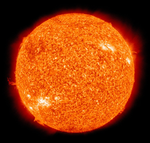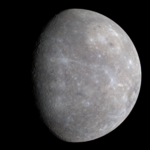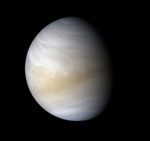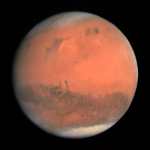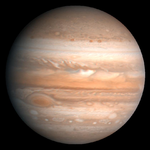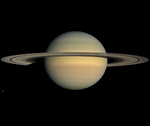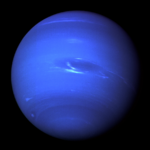Difference between revisions of "Gravitational Field Strength"
(→Examples) |
(→Key Stage 4) |
||
| Line 57: | Line 57: | ||
*The [[mass]] of the [[moon]], [[planet]] or [[star]] - The larger the [[mass]] the greater the '''gravitational field strength'''. | *The [[mass]] of the [[moon]], [[planet]] or [[star]] - The larger the [[mass]] the greater the '''gravitational field strength'''. | ||
*Distance from the [[Centre of Mass|centre of mass]] of the [[moon]], [[planet]] or [[star]] - The larger the [[distance]] the smaller the '''gravitational field strength'''. | *Distance from the [[Centre of Mass|centre of mass]] of the [[moon]], [[planet]] or [[star]] - The larger the [[distance]] the smaller the '''gravitational field strength'''. | ||
| + | |||
| + | {| class="wikitable" | ||
| + | |+ Gravitational Field Strength of Different Celestial Objects | ||
| + | |- | ||
| + | | style="height:20px; width:200px; text-align:center;" |'''[[The Sun]]''' | ||
| + | | style="height:20px; width:200px; text-align:center;" |'''[[Mercury]]''' | ||
| + | | style="height:20px; width:200px; text-align:center;" |'''[[Venus]]''' | ||
| + | | style="height:20px; width:200px; text-align:center;" |'''[[Earth]]''' | ||
| + | | style="height:20px; width:200px; text-align:center;" |'''[[The Moon]]''' | ||
| + | |- | ||
| + | |[[File:TheSun.png|center|150px]] | ||
| + | |[[File:Mercury.png|center|150px]] | ||
| + | |[[File:Venus.png|center|150px]] | ||
| + | |[[File:Earth.png|center|150px]] | ||
| + | |[[File:TheMoon.png|center|150px]] | ||
| + | |- | ||
| + | | style="height:20px; width:200px; text-align:center;" |290N/kg | ||
| + | | style="height:20px; width:200px; text-align:center;" |3.7N/kg | ||
| + | | style="height:20px; width:200px; text-align:center;" |8.8N/kg | ||
| + | | style="height:20px; width:200px; text-align:center;" |9.8N/kg | ||
| + | | style="height:20px; width:200px; text-align:center;" |1.7N/kg | ||
| + | |- | ||
| + | | style="height:20px; width:200px; text-align:center;" |'''[[Mars]]''' | ||
| + | | style="height:20px; width:200px; text-align:center;" |'''[[Jupiter]]''' | ||
| + | | style="height:20px; width:200px; text-align:center;" |'''[[Saturn]]''' | ||
| + | | style="height:20px; width:200px; text-align:center;" |'''[[Uranus]]''' | ||
| + | | style="height:20px; width:200px; text-align:center;" |'''[[Neptune]]''' | ||
| + | |- | ||
| + | |[[File:Mars.png|center|150px]] | ||
| + | |[[File:Jupiter.png|center|150px]] | ||
| + | |[[File:Saturn.png|center|150px]] | ||
| + | |[[File:Uranus.png|center|150px]] | ||
| + | |[[File:Neptune.png|center|150px]] | ||
| + | |- | ||
| + | | style="height:20px; width:200px; text-align:center;" |3.7N/kg | ||
| + | | style="height:20px; width:200px; text-align:center;" |24N/kg | ||
| + | | style="height:20px; width:200px; text-align:center;" |11N/kg | ||
| + | | style="height:20px; width:200px; text-align:center;" |9.0N/kg | ||
| + | | style="height:20px; width:200px; text-align:center;" |12N/kg | ||
| + | |} | ||
Revision as of 12:31, 11 February 2019
Contents
Key Stage 3
Meaning
Gravitational Field Strength is the force on an object per kilogram in a gravitational field.
About Gravitational Field Strength
- On Earth gravitational field strength is roughly 10 Newtons for each kilogram of mass (10N/kg).
- Different objects have different gravitational field strengths.
Examples
| The Sun | Mercury | Venus | Earth | The Moon |
| 290N/kg | 3.7N/kg | 8.8N/kg | 9.8N/kg | 1.7N/kg |
| Mars | Jupiter | Saturn | Uranus | Neptune |
| 3.7N/kg | 24N/kg | 11N/kg | 9.0N/kg | 12N/kg |
Key Stage 4
Meaning
Gravitational Field Strength is the force on an object per kilogram in a gravitational field.
About Gravitational Field Strength
- At sea level on Earth the gravitational field strength is 9.8 Newtons for each kilogram of mass (9.8N/kg).
Gravitational Field Strength depends on:
- The mass of the moon, planet or star - The larger the mass the greater the gravitational field strength.
- Distance from the centre of mass of the moon, planet or star - The larger the distance the smaller the gravitational field strength.
| The Sun | Mercury | Venus | Earth | The Moon |
| 290N/kg | 3.7N/kg | 8.8N/kg | 9.8N/kg | 1.7N/kg |
| Mars | Jupiter | Saturn | Uranus | Neptune |
| 3.7N/kg | 24N/kg | 11N/kg | 9.0N/kg | 12N/kg |
